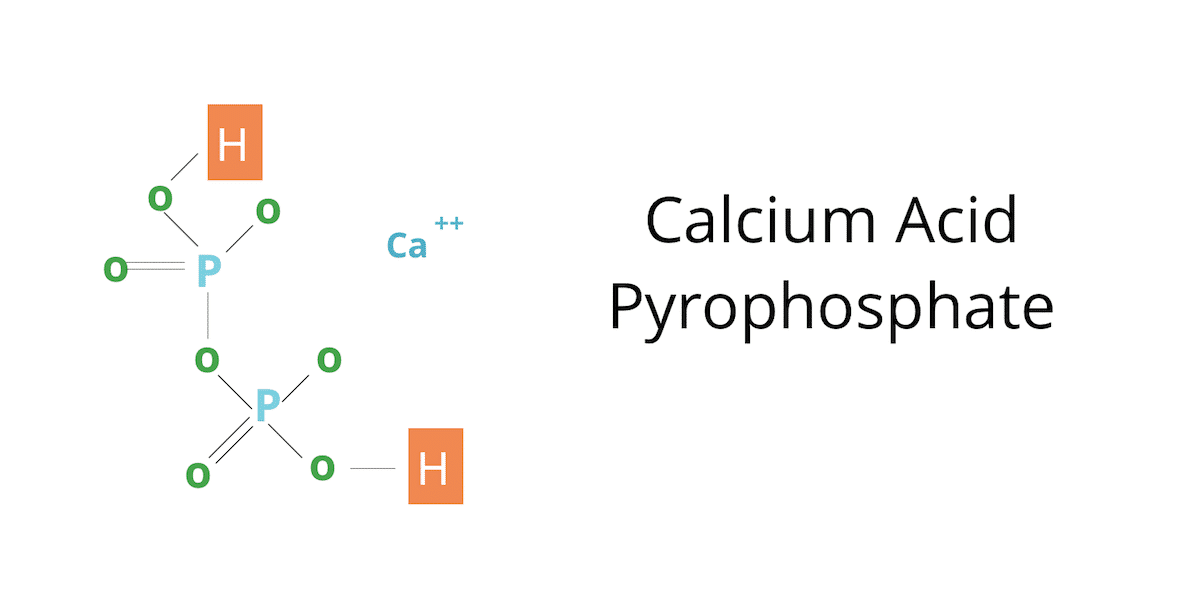Calcium Acid Pyrophosphate (CAPP)
Calcium Acid Pyrophosphate (CAPP) is an anhydrous phosphate salt. It appears as a fine, white powder and is produced from two main raw materials: Calcium Hydroxide and Phosphoric Acid. Some are produced with Calcium Carbonate and Calcium Oxide. [1] CAPP is used mainly as a raising agent in the baking industry, particularly in quick breads and sweet bakery products. It is also utilized as a complementary nutrient source for calcium which can potentially improve the nutritional content of the food it’s used in, especially as a nutritionally improved alternative of Sodium Acid Pyrophosphate. [1] CAPP is also flavor neutral compared to its Sodium-based counterparts.
Why is Calcium Acid Pyrophosphate used?
Baking
There are two main parameters critical for baking performance: Neutralisation Value (NV) and Rate of Reaction (RoR).
● NV is described as the amount necessary to neutralize a hundred grams of Sodium Bicarbonate. The higher the value, the less raising agent or leavening acid needed. In the food industry, the less raw materials you need to produce a quality product, the more profitable the product becomes.
● RoR is the speed of the release of Carbon Dioxide (for volume) during the leavening reaction. The speed of the reaction matters when it comes to the product’s physical qualities as well as palatability.
CAPP has a fairly high NV without sacrificing RoR which makes it a cheap yet effective alternative for a variety of baking applications.
Other than as a leavening agent, CAPP is also able to improve the properties of microwavable food. It enhances absorption of microwaves which results in better heating and texture. [1]
Low-Sodium Diets
Patients with heart failure and other forms of heart diseases are often asked to adhere to a low-sodium diet. [2] Using CAPP as an alternative to Sodium Acid Pyrophosphate allows the food to have significantly less sodium and make the food product healthier for those on a low-sodium diet. [2,3] Experts say using CAPP over Sodium-based leaveners can provide as much as 25% reduction in sodium content. [4]
Calcium Content
CAPP provides around 19% calcium which may allow the use of “good” or “excellent” source of calcium in products.
Arguments against the use of Calcium Acid Pyrophosphate in food
No health studies currently argue against the use of CAPP. However, one issue is with the powder not being “vegan,” due to the potential use of animal bones but there are companies that produce vegan forms of CAPP. Common Substitutes for calcium acid pyrophosphate in food ingredients or food processing include other calcium-based substitutes include Monocalcium Phosphate, Anhydrous Monocalcium Phosphate, and Dicalcium Phosphate Dihydrate.
Is Calcium Acid Pyrophosphate natural?

Calcium acid pyrophosphate is produced from two main raw materials, either a calcium hydroxide (lime, Ca(OH)2) or calcium oxide (burned lime, CaO) or calcium carbonate (CaCO3), or a combination of both and phosphoric acid (H3PO4).
● Food-grade Calcium Hydroxide, or (lime, Ca(OH)2), is well-known as “Pickling lime,” is used during the pickling process to give pickles an extra crunch.
● Calcium carbonate, or CaCO3, comprises more than 4% of the earth’s crust and is found throughout the world. Its most common natural forms are chalk, limestone, and marble, produced by the sedimentation of the shells of small fossilized snails, shellfish, and coral over the course of millions of years.
● Phosphoric acid, or (H3PO4), is made from the mineral phosphorous. Phosphorous is found naturally in the body and helps form strong bones and support kidney function. Phosphorous is also necessary to produce the genetic codes of all living things, DNA and RNA.
Is Calcium Acid Pyrophosphate allowed in Paleo, Keto, and Grain Free Gluten Free Certification?
As a natural preservative, Calcium Acid Pyrophosphate (CAPP) is approved for use in Paleo Certified, Keto Certified, and Grain Free Gluten Free Certification Programs.
References:
1. FDA, (2018). [online] Available at: nventory/ucm593669.pdf [Accessed 20 Jun. 2018].
2. Graudal NA, Hubeck-graudal T, Jurgens G. Effects of low sodium diet versus high sodium diet on blood pressure, renin, aldosterone, catecholamines, cholesterol, and triglyceride. Cochrane Database Syst Rev. 2017;4:CD004022.
3. USDA, (2018). [online] Available at: %20Pyrophosphate%20TR.pdf [Accessed 20 Jun. 2018].
4. Abmna.com. (2018). To go LOW or NOT | AB Mauri | NA. [online] Available at: http://abmna.com/to-go-low-or-not/ [Accessed 20 Jun. 2018].
